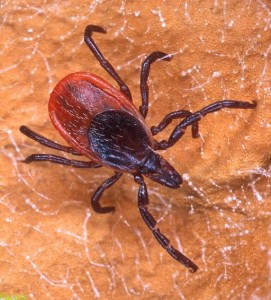Tick alert
July 29th, 2008
Not to scare you or anything, but WATCH OUT FOR TICKS!!!
Gardeners are naturally more prone than couch potatoes to the chronic arthritic and neurological woes of Lyme disease, spread by the increasingly common blacklegged tick.
Penn State urban entomologist Steve Jacobs said at the 2008 Woody Plant Conference at Swarthmore College that Pennsylvania is a national hot-spot for Lyme – a problem now up to 300,000 cases a year in the U.S. and rising.
June and July are the top two months for infection.
Although the adult stage of this tick can overwinter on deer, the favored hosts of the nymph stage (the one that usually infects humans) are mice, squirrels, chipmunks and other small rodents and small birds.
Jacobs says blacklegged ticks prefer the cool, humid conditions of leaf litter in wooded areas and in tall brush and grasses. They hate mowed lawns or other sunny areas where they quickly dry out.
Lyme usually starts out with a bulls-eye rash and symptoms such as fever, headaches and back, neck and muscle pain. Chronic symptoms include arthritis and a host of neurological maladies.
Jacobs says the best defense is to check yourself for ticks whenever you or a pet has been outside.
If a tick is removed within 24 hours, there’s little chance of being infected. Even when an embedded tick is removed within 72 hours, one 200-milligram tablet of doxycycline (an antibiotic) prevents trouble 87 percent of the time, Jacobs says.
Better yet, guard against getting ticks in the first place. Some tips:
* Wear light-colored clothes. It’s easier to spot the black ticks.
* Apply a repellent before going out. DEET is the most commonly used. Read the label before using, especially if you’re thinking about applying it on kids.
* Reduce woodland undergrowth, eliminate weeds and tall grasses, and thin out trees to let in more light. “I know that might run counter to the trend,” says Jacobs, “but this is one of the consequences of letting your land go back to a native state.”
* Fence out deer and take steps to reduce your rodent population.
* Consider a granular tick-killer over suspected tick habitats. Labeled insecticides include bifenthrin, cyfluthrin, deltamethrin, permethrin and carbaryl.
* If you find a tick, remove it or have a doctor remove it by grasping the head (the tick’s, not the doctor’s) with forceps and pulling straight up. “Don’t use Vaseline or nail polish or hot matches,” says Jacobs. “You don’t want the tick to regurgitate.”
* Most ticks survive a trip through the washing machine. Only an hour in a hot dryer reliably kills them.
* Neither are ticks completely dormant even in cold weather. They’ve been found active here in January and February down to a temperature of 28 degrees. “The only time you’re really safe is when there’s snow on the ground,” says Jacobs.
A good source for more information: download Connecticut’s “Tick Management Handbook” at http://www.ct.gov/caes/lib/caes/documents/publications/bulletins/b1010.pdf.








